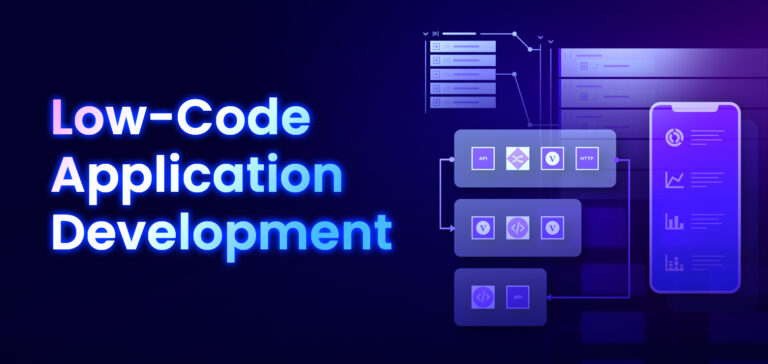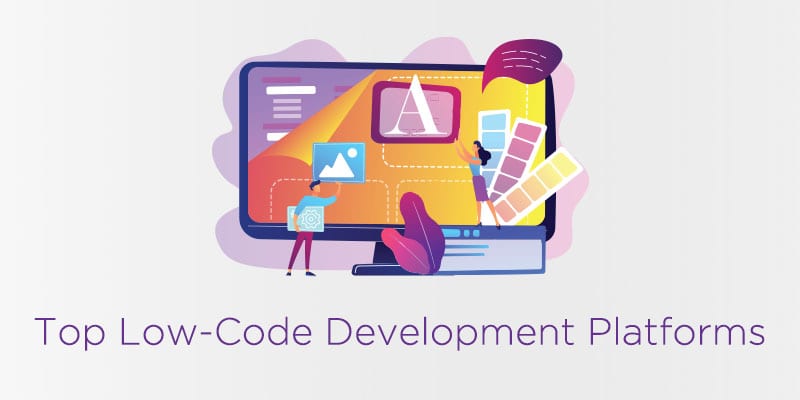Best Tips To Picking Low-Code Platform Examples
Wiki Article
Advantages Of Low-Code Application Development In Terms Of Integration Capabilities
Low-code development of applications offers huge advantages in the area of integration capabilities. These are essential for creating applications that are able to seamlessly connect to diverse systems and services. Here are a few major advantages of Pre-built connectors and APIs.
Many Connectors to Choose From: Low-code platforms typically come with a vast library of connectors that are pre-built for the most popular enterprise systems (e.g. CRM, ERP databases, cloud services, etc.). This simplifies the process of integration with these systems.
API Integration: Many low-code platforms include integrated APIs that are built-in which allow developers to connect easily with external data sources and services.
Usability:
Drag-and-Drop Interfaces: Several integration tasks are easily accomplished using drag-and-drop interfaces. This makes it feasible for developers and others who are not developers to develop complex systems with out lengthy programming.
Visual Workflow builders: These visual tools are used for designing workflows, data flow and integrations. They aid in understanding and setting them up more easily.
Standardized Integration Methods:
SOAP and RESTful Service Support for web services protocols like SOAP and REST allows simple integration with a variety of external systems and applications.
OData Standards and Other Standards Support for standards, like OData, allows easy access to data and its manipulation across different platforms and applications.
Real-Time Data Synchronization:
Low-code platforms allow for real-time integration between systems and applications. This allows information to be updated and consistent across all departments of the company.
Event-Driven Architect: Certain platforms come with structures that are event driven, allowing applications to respond instantly to events. This is important for dynamic interactive applications.
Legacy System Integration:
Connecting old Systems and New Systems Low-code platforms often provide tools for integration with existing old systems. This allows organisations to modernize their IT Infrastructure without overhauling the existing systems.
Data Migration Tools Built-in data migration tools allow you to move data from old systems to applications that use low-code.
Integration of Third-Party Services:
Integration with Cloud Services: Seamless integration with cloud services such as AWS, Azure, and Google Cloud allows for the ease of deployment and scaling applications.
Business Applications Integration Lowcode platforms can be used to integrate various business applications, such as Salesforce, SAP, Microsoft Dynamics etc. to create a seamless workflow among different business functions.
Simplified Data Processing
Unified data models: A few platforms that offer low-code support for unified data models to facilitate data management across platforms.
Data Connectors Pre-configured data connectors make it easy to access and alter data from many sources.
Security and Compliance
Secure Integrations: Low-code platforms ensure that integrations comply with security protocols and standards, assisting to secure data both during transport and in storage.
Compliance Features - These platforms include features to ensure the integrations are compliant with the regulatory regulations.
Extensibility:
Low-code platforms permit the addition of customized scripts and codes to meet more complex integration requirements. This flexibility is available without compromising ease of use.
Plug-in Ecosystems: A plugin ecosystem can be used to extend the integration capabilities, and allow users to add additional functionalities when needed.
Overall, the integration capabilities of low-code development platforms make them an effective instrument for developing interconnected, efficient and scalable applications. They simplify the process of connecting disparate systems, increase data flow, and enable enterprises to use existing technology while embracing new ones, thereby ensuring the integration of a seamless IT environment. See the most popular Low-code Platform for application development for more info including develop web app, database in azure, rapid action development, push notifications android, rapid action development, cross platform mobile dev, cross platform app dev, push notifications, rapid action development, application development platforms and more.

Scalability And Flexibility Are The Two Advantages Of Low-Code Application Development
Low-code application development offers several advantages when it comes to adaptability and scalability, which are crucial for building applications that can grow with business needs and be able to adapt to the changing demands. Here are a few major advantages rapid scaling:
Cloud-based deployment: Many lowcode platforms run on the cloud, allowing applications to scale with the infrastructure. This allows businesses to handle more workloads without having to worry about managing servers.
Auto-Scaling: The auto-scaling function allows you to automatically adjust resources based on the demand. This will ensure the same performance even during peak hours, without any manual intervention.
Flexible Architecture:
Modular Design: Low-code platforms encourage modular design of applications, in which components can be created independently as well as tested and scaled. This flexibility increases flexibility and makes it easier to expand or update specific components of an application without affecting the entire system.
Microservices Integration : Supporting microservices, applications can be created using loosely-coupled service to improve flexibility and scalability.
Customizable Solutions:
Extensibility: Low code platforms typically allow customized scripting and programming, which lets developers expand the capabilities of their applications beyond that available out-of the-box. This allows for unique business needs to be fulfilled without restrictions.
Third-Party Integrations: The capacity to integrate with third-party applications and APIs allows companies to add additional functions and services as needed to enhance the functionality of the application.
Agile Development and Deployment
Continuous Delivery & Deployment Low-code Platforms facilitate agile methods by enabling continuous Integration and Continuous Delivery (CI/CD). This allows for rapid deployment of updates and new features, ensuring that the application can be updated quickly in response to user feedback and market shifts.
Iterative Development: Thanks to the iterative nature low-code programs can scale and grow incrementally. This reduces the potential risk of major changes and allows for more controlled expansion.
Resource Optimization
Efficient Resource Management: Low-code platforms assist maximize the use of resources by offering tools for monitoring and managing application performance. This helps ensure that resources are utilized efficiently and can be scaled up or down based on the actual requirements.
Load Balancing: The integrated load balancing feature divides the workload equally among servers. This improves the system's capacity to handle the demands of high traffic and also ensures constant performance.
Global Reach:
Multi-Region Deployment: Low-code systems typically support deployment across several geographical regions, allowing businesses to provide low-latency access to users worldwide. This is particularly important for applications which have users across the globe.
Support for Localization Built-in support for localization allows applications to be easily adapted to different languages and the requirements of diverse markets.
Maintenance and updates:
Simplified Maintenance: The aesthetic and modular design of low-code applications makes maintenance easier which allows bugs and updates to be completed quickly and without extensive downtime.
Version Control: Integrated version control systems handle rollbacks and changes to ensure that updates can safely be made and that older versions can be restored if needed.
Cost Efficiency:
Low-code platforms can cut development costs by reducing the need for complex code. They allow developers to expand applications without need for a significant expenditure or effort.
Pay-Asyou-Go Models Many low code platforms offer flexible pricing, such as the pay-asyou-go model that aligns prices to usage as well as growth. This gives the flexibility to budget.
Overall the scalability and flexibility advantages of low-code application development enable businesses to build robust, flexible and scalable apps efficiently. These platforms permit rapid changes to meet changing demands, efficient resource utilization, and constant improvement. Applications can evolve and adapt to the changing needs of business. View the top rated Enterprise application development with Low-code Platform advice for website info including app development platform, database in azure, lowcode no code, software for app development, low code platforms, develop cross platform mobile app, push notifications android, sso azure, cross platform app development, azure sql server and more.

Advantages Of Low-Code Application Development With Respect To Limitations And Customization
Low-code development is an approach that is balanced to address limitations, while also allowing the possibility of customizing. Here are some of the major advantages: Handling limitations
Overcoming Complexity Barriers
Simple development: Platforms that use low-code reduce the amount of work by supplying templates and components pre-built for you that allow for quicker development and deployment for complex applications.
Numerous platforms offer wizards and guided workflows to help developers navigate difficult procedures. These tools minimize the risk of mistakes and also help to ensure the consistency of.
Scalability Solutions
Scalability is built into: Low-code platforms typically include features that allow for the development of scalable architecture. Applications can handle increased demands with little development.
Performance Monitoring: Integrating tools for performance monitoring as well as tuning, optimization and tuning can help applications scale efficiently.
Security and compliance
Low-code platforms come with security features such as security access control based on role, encryption, and automated checks to ensure security compliance. These measures address the commonly-asked security issues.
Regular Updates: Platforms regularly change their security protocols as well as security measures to ensure that their applications are secure against emerging threats.
Customization Features:
Extensibility:
Low-code Platforms Support Custom Code They allow the integration and the use of customized code.
Custom Modules and Plugins: Developers can have the option of designing custom modules or plugins to modify specific functionality to meet the specific requirements of a particular business.
APIs and Integration
API Support: The extensive API support permits seamless integration of external systems and services. This facilitates the ability to customize and connect.
Third Party Services: Low-code platforms typically have pre-built connectors to popular third-party services, which makes it easier to integrate and customize applications.
Flexible UI/UX:
Customizable user interfaces: Developers are able to modify and design the user interfaces so that they meet specific branding requirements and requirements for usability, resulting in the user with a customized experience.
Responsive Design: The apps can be tailored to fit different screen sizes and devices.
Business Logic Customization
Visual Workflow Builds Visual tools that permit customization of business workflows and rules as well as to design complicated, tailored processes.
Conditional Logic and Scripting: Platforms permit the integration of conditional logic as well as custom scripting that can handle certain business rules and scenarios.
Data Management:
Custom Data Models Developers have the ability to create customized data models for specific applications, tailoring data handling to the specific requirements of business.
Advanced Data Processing: The integration of advanced data processing capabilities and tools allow for customization of the method of analyzing data within an application.
Balancing Limitations with Customization:
Frameworks and Standards
Best Practices for Compliance Low-code platforms promote adhering to industry best practices and standards. This helps in maintaining high-quality, scalable, and secure applications.
Governance Frameworks - Built-in governance frameworks ensure that customizations don't affect security, integrity, or the observance of regulations.
Iterative design and feedback:
Rapid Prototyping. The ability to speedily prototyping and testing modifications allows developers to iterate the application based on the feedback of users. This helps refine the application to better satisfy the needs of users.
Low-code platforms are designed to enable continuous improvement. This allows for customizations and improvements as requirements for business change.
Empowering Users
The empowerment of citizens-developers through low-code platforms increase the number of contributors capable of enhancing and customizing applications, by giving them the ability to modify their applications through an intuitive user interface.
Support and Training Resources: Many platforms provide extensive training and support materials that allow users to modify applications without jeopardizing their performance or stability.
In general, low-code development offers a robust system for dealing with limitations, as well as a wealth of opportunities to personalize. This balance allows businesses to build and maintain functional applications designed to meet their requirements while maintaining high standards for quality, security and scalability.
